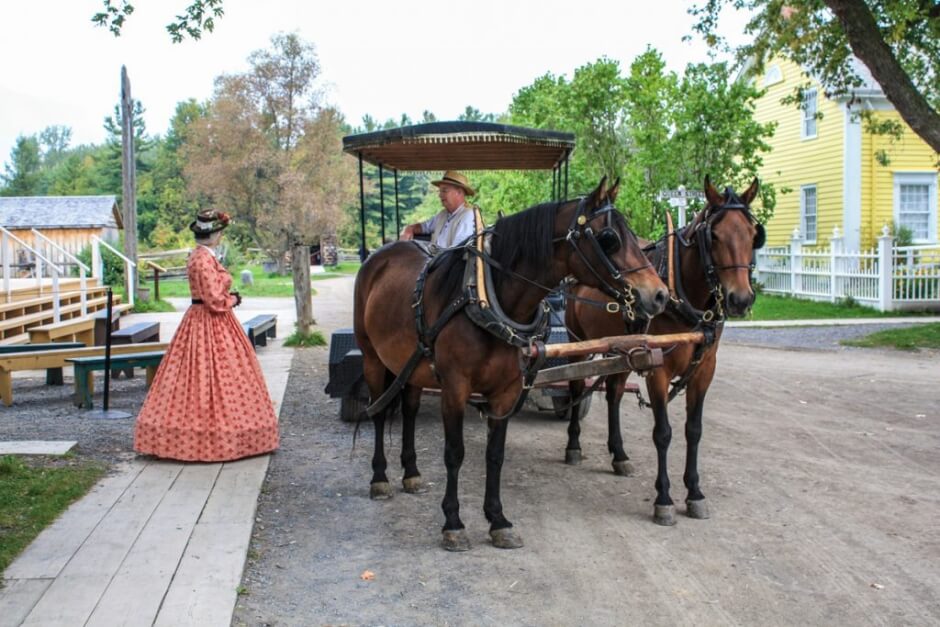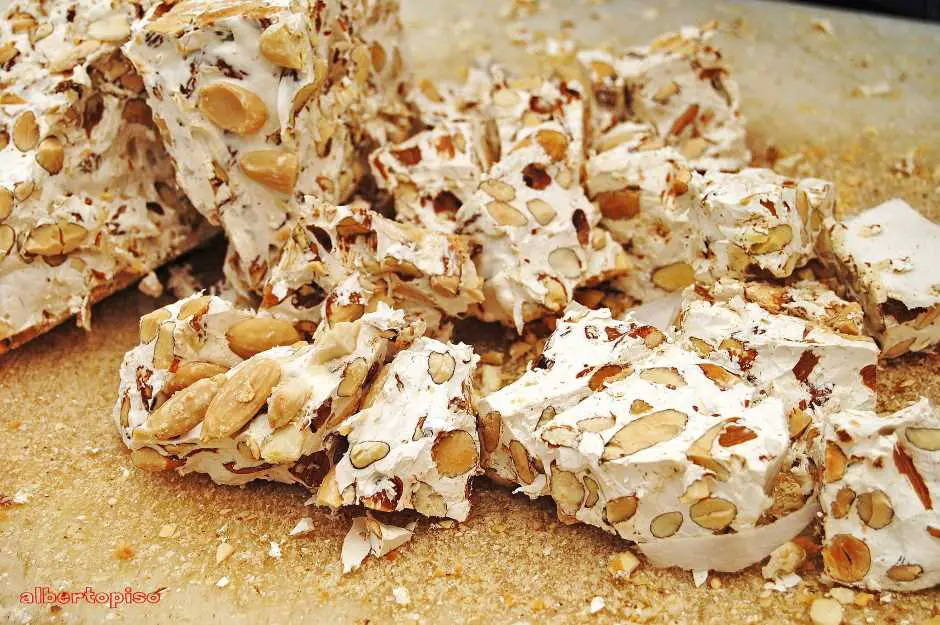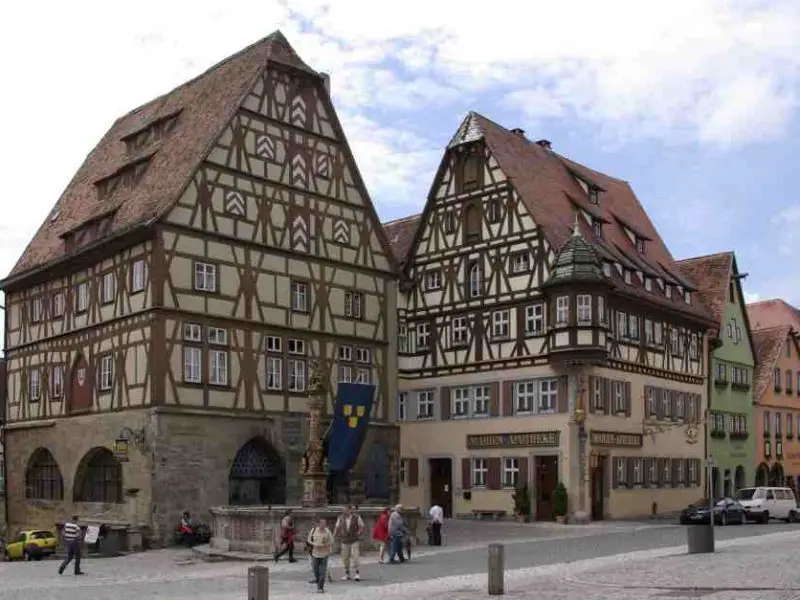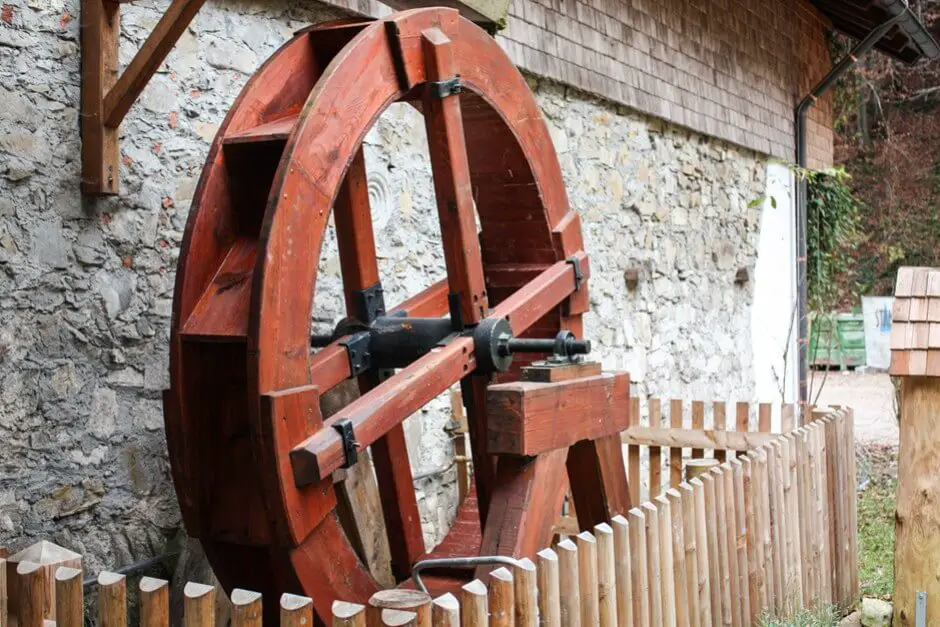In the Upper Canada Village you will immerse yourself in the history of Ontario. Today's Ontario is shaped by Canada's most important industrial center at the Golden Horseshoe, a conglomerate of several cities that have grown together to form a huge metropolis with more than eight million inhabitants. Toronto and its suburbs form the most densely populated region in Canada.
Ontario in 19. Century in the Upper Canada Village
But that was not always so. Still in the middle of the 19. In the 19th century, Ontario was a rural province where most people lived from farming and processing agricultural products.
Until 1834, Toronto was named York after a member of the British royal family, and not infrequently people made fun of "Muddy York," the muddy York: A common joke of the time tells how a man walked the city on one of the boardwalks, which served as pedestrian paths at that time. He saw a hat lying on the street and picked it up. Amazed, he saw the head of a man standing out of the morass and asked him if he could help him. He shook his head and said, "It's okay, but if you could help the horse under me?"
It did not look so bad in the capital of Upper Canada, which became 1867 with the formation of the Canadian Confederation into the new province of Ontario. But a reason for this joke certainly provided the city. And in the countryside conditions were guaranteed even easier.
Time travel into the past
We embark on a search for life in the Ontario middle of the 19. Century and visit the Upper Canada Village at Morrisburg, which is located between Kingston and Montreal on the banks of the St. Lawrence River. The village was built by 1958 during the construction of the shipping canal, which allows seagoing vessels to navigate through a complex lock system to the center of the American continent. In the construction of the St. Lawrence Seaway, ten villages were flooded on the banks of the stream, and many of the buildings threatened with destruction were rebuilt in the newly-created museum village.
Since the opening of the open-air museum in the year 1961, life in an Anglo-Canadian village in the year 1866 has been shown, with everything that goes with it: farms, farmland, a village church, a school, a tavern, the processing companies of the time and people who owned the Everyday tasks in the life of a villager in Ontario pursue. We take half a day to explore this village idyll on the banks of Stankt Lorenz.
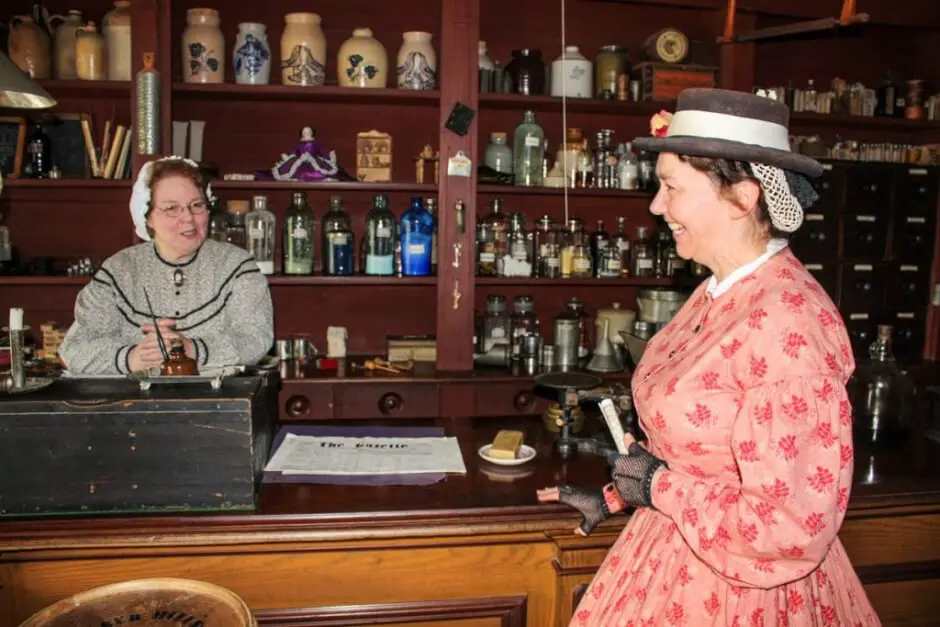
Memorial to the Battle of Crysler Farm
Before we get to the visitor center of the Upper Canada Village, we pass a park-like memorial for the battle of Crysler Farm, which took place on November 11, 1813 during the last armed conflict between the English and the Americans on North American soil. The battle proved crucial to the war and took place just a few miles from what is now the Upper Canada Village. Since the scene of the battle was flooded when the sea route was built, it made sense to set up the memorial in front of the museum village.
Gabriele Thomas, an Austrian, who emigrated to Canada years ago and now works as a senior supervisor in the Upper Canada Village, awaits us in the visitor center of the museum village. She wears a costume of the times with a long skirt and wide crinoline. She leads us through the village and explains to us in the most beautiful Austrian dialect what we will see on the way. We learn a lot about the background to the war of 1812 and how it broke out. Only then do we enter the world in the middle of the 19th century.
So you lived in Ontario center of the 19. century
Everywhere splashing, dripping and rustling: that's the first thing that strikes me. All the machines we see in the village are powered by water. An ingenious system of channels branches off the village pond and ensures that saws, mills, looms and other technical achievements of the time to date run reasonably smoothly.
And so it keeps pounding out of the blacksmith's house, crunching the millstones out of the mill as they grind the freshly delivered grain into flour, rattling the numerous looms in the weaving mill and yelling the saws that break huge tree trunks into boards. There is a bustling mess in the village and people are busy at work everywhere.
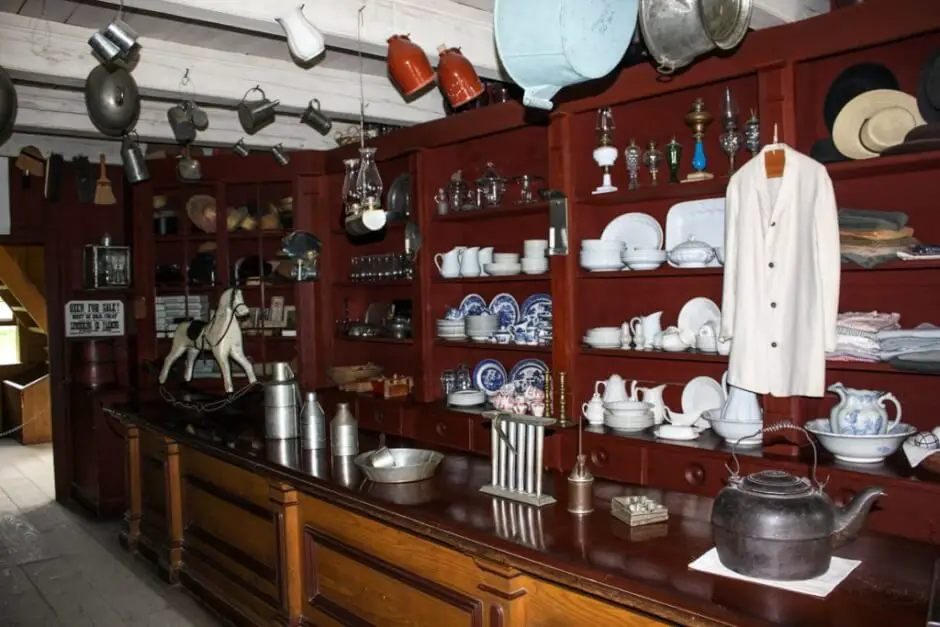
Nevertheless, one does not have the impression that hecticness determines the daily routine. On the contrary, everyone takes time for a chat and a conversation, while in the background his well-maintained machines do their job: the miller tells us he gets his flour from the farmers in the village. And that's literally because crops are cultivated in the fields of the Upper Canada Village, just as in the year 1866 in the villages on the St. Lawrence River.
This is how you worked in 19. Century in Ontario
Everywhere in the village you work - flour is ground in the mill and finally baked at the village bakery to delicious and wonderfully fragrant bread, which is served to guests in the village tavern. Gabriele tells us: "The bakers produce too much bread, and we supply the surplus of bakeries in the area. The revenues help us to maintain museum operations. "
In the sawmill, a huge man proudly shows us the several meters long board that his water-powered saw has just cut from a thick tree trunk, and in the weaving mill, under our curious eyes, the weaver struggles with the technical pitfalls of his loom, which is not so want how he wants it. Only after some back and forth do the threads run as desired. He explains to us that these old, original looms are not always easy to operate. And he reports that the blankets, towels and fabrics that he produces adorn the tables, beds and even the people in the village.
Whether tablecloths, bedding or clothing - everything is made from the materials from the village weaving mill. Anyone who wants can give him orders, and he makes blankets as desired: striped, checkered or uni. He is currently working on such a piece, and we are fascinated to see how the wool blanket takes on more and more form. She gets pretty with her different colored stripes, and I can well imagine that she looks good as a warm blanket, which is decoratively draped over the backrest of a living room sofa.
A walk through the village
Gabriele leads us deeper into the village. Cleverly she overcomes stairs, glides despite her wide crinoline elegantly between narrow bridge railings and past dense bushes without the fine fabric of her dress hanging on the branches and tears and moves in her pretty dress so perfectly, as if she nothing else would have done for a lifetime.
I ask her if it is not difficult to move in such a bulky garment, and she laughs, "You get used to it. Only at the beginning you have to pay attention to where you step. "And she continues to float in front of me, with her skirts make a loud audible rustle.
She seems to be quite popular in the village, because everywhere she goes, she is greeted with a smile, and there is a little chat, just as I imagined life in the "good old days". In front of the village tavern we meet the coachman of the village who is waiting for passengers. He sits enthroned on his coach and patiently holds the reins in his hand. In front of his car, he has two horses stretched, which - as he tells us proudly - are bred in the village.
This is what you need to visit the Upper Canada Village
- We recommend comfortable walking shoes for the walk.
- Practical is also a backpack in which you store a drink, snack, a jacket and other odds and ends.
- Do you have everything? With our hiking checklist you can easily check that.
Even the horses are special
This is a very special breed: the "Canadian Horses" were the ones in the 19. Century most widespread breed of horses in the farms of Upper Canada. The Canadian government even gave 2002 the dignity of a "National Horse of Canada," an honorary title that expresses its contribution to Canadian history. Smaller in size, they are nevertheless strong and excellent for working in the fields and as draft animals for the small carriages that were used to move on the bumpy roads of the time.
He is especially proud of the rearing of these horses, as they were almost extinct. The Upper Canada Village bought 1978 a stallion and two mares. Today, the museum village has a herd of 18 animals.
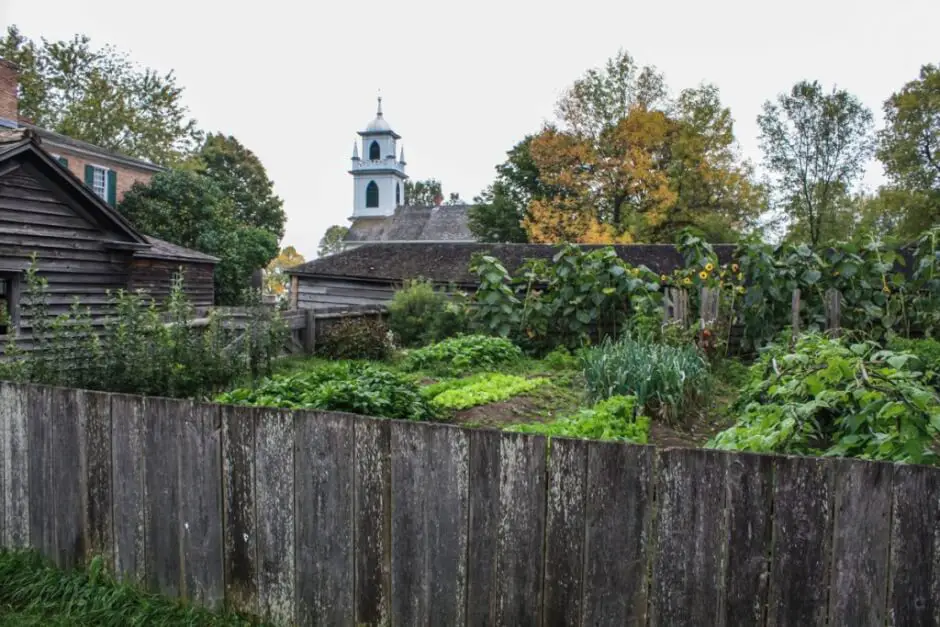
Guest at the tavern in Upper Canada Village
Of course we will not miss the visit to the Cook's Tavern, whose front door announces that "wine, beer and other spiritual and fermented drinks" may be served here: Michael Cook was a German immigrant from the Mohawk valley, who lived in the The turmoil of the American Revolution remained faithful to the British and therefore moved on to Canada, where he opened his tavern to 1804.
He had chosen an excellent location for this, as his customers came by both waterway via the St. Lawrence and by land across the Kings Highway between Kingston and Montreal past his establishment.
Gabriele tells us that there were rooms in his tavern that were reserved exclusively for women, while in others the male visitors drank together, exchanged information about the latest developments and played cards. The landlord welcomes his guests personally and sneaks at them when they - like an older gentleman before us - only enter his inn in shorts and thus inappropriately dressed according to his standards.
There was news in the tavern or church
We are interested in reading the posters hanging on the wall of the tavern: oxen are offered for sale, an event in the school is announced, new taxes are due, and one even offers money for grain. These publications come from the Dorfer's printing house, which often took on the function of a newspaper at the same time.
Related to the latest news about such new-fangled facilities as the telegraph connections, which even quickly conveyed news from the most remote regions of the country in all areas. However, the details of the headlines were often only months after the actual event.
There is a kiosk in front of the village church where the latest news is posted. Other posters warn of pickpockets who are up to mischief in the community. The church tower dominates all other buildings in the village. The congregation belonged to the Church of England, so the interior of the church building was rather unadorned. Even a cross and candles are missing, because these were things that were frowned upon in Anglican churches at the time. The front pews were available to parishioners for a fee. The rear pews and the gallery were free and could be used by guests.
Cabbage in the garden of the Upper Canada Village
Gabriele leads us past the village green, which is surrounded by deciduous trees growing in the middle of vegetable gardens. Cabbages thrive alongside carrots and potatoes. Pumpkins add pops of color to vegetable beds. A farmer is raking his beds. We ask him what he does with his vegetables: "Most of them are for my family, of course. We store most of it for the winter, but we sell some to the tavern.”
On our way down the village road, we meet a farmer whose horse trudges leisurely in front of his carriage. He greets you kindly but does not stop. Obviously, he has a fixed goal.
Are you traveling with a motorhome?
- The campground is the Upper Canada Campground; 13390, Upper Canada Rd, Morrisburg, ON K0C 1X0, Canada, Tel. +1 613-543-2201. There are other campsites in the area. See below.
- Do you want to rent a motorhome? Then you will find information here as well as booking options.
- Check our packing list for campers to see whether you have packed everything for your motorhome tour.
- Don't forget your large backpack . There are beautiful hiking opportunities in the area.
Shopping in Ontario of the 19. century
In the 19th century, there wasn't much to choose from for shopaholics, which is no surprise given that goods were traded in kind. money was scarce. In the village bakery, from which the smell of freshly baked goods wafts towards us, we observe the baker's apprentice as he watches his teacher as he takes bread out of the oven. He doesn't seem to be particularly industrious, the next scion of the bakers. But what is not, can still become. After all, he's only 13 years old.
In the village shop we find everything that the farming family of the time desires. Fabrics and borders, tea and tools, sugar and spices, pots, pans, baskets and even medicines. If someone had mail to send, they brought it to the store, paid their fee - or not. In this case, the recipient of the letter was expected to pay the postage. If he didn't do this, the letter remained lying around until it was picked up.
The village school in the Upper Canada Village
The school in the village was an elementary school where the children learned to read, write and do arithmetic. In addition, they received a basic knowledge of history, the natural sciences and proper behavior and the moral concepts of the time. Usually they attended the school for six years. Very few had the opportunity to go to college. Parents could not afford to send their children there.
Crysler Hall - the village dealer lived here
The grandest house in Upper Canada Village is Crystaller Hall, which differs from the farmhouses in the village with its front garden and pillars at the main entrance. It was the home of John Pliny Crysler, a lumber merchant on whose farm the Battle of Crysler's Farm was fought. Crysler's home was lavish, and such buildings were rare in 19th-century Ontario. Today, exhibitions are held in the rooms of Crystaller Hall.
Artisans and farmers in the Upper Canada Village
More common were the farm buildings with their barns and stables located at the end of the village near their fields. But here, too, there were differences: Farmers who leased their farmland usually saved until they could afford a farm. They hardly invest in the leasehold farm. In this way, the farms that were owned by their operators could usually be easily distinguished from those that were leased from large landowners.
In addition to the farmers, important villagers were the craftsmen who had specialized: there was the village blacksmith, the seamstress, the shoemaker and the can maker. In the cheese factory, the milk from the cattle and sheep was processed into cheese. The village notables included the doctor and the village priest.
A visit to Upper Canada Village is like stepping back in time to another era. People took time for each other, met in church, over a beer in the tavern or for a chat in the village shop. And you worked hard. Be it in the fields, in the workshop, in the shop or in one of the businesses in the village. If you want to explore the museum village in detail and immerse yourself in this time, you should plan half a day for the visit.
Upper Canada Village
13740 County Road 2
Morrisburg ON K0C 1X0
Park visit to this Ontario attraction
Nearest Ontario village to Upper Canada Village is Morrisburg
Arriving by plane and / or car
Compare and book flights here* (Advertisement). One airport is Toronto or Montreal. From there you can travel by rental car or motorhome.
Car Rentals:
Cheap car hire - book quickly and easily!
Accommodations near the Upper Canada Village
Hotels and accommodations around the Upper Canada Village * you can, for example, book through our partner booking.com.
Long Sault Camping
In addition to Upper Canada Campground, 13390, Upper Canada Rd, Morrisburg, ON K0C 1X0, Canada, there are campgrounds on the Long Sault Parkway. Staying overnight is recommended if you continue towards Montreal. This means a detour off Hwy. 2. However, the route passes through the Parks of the St. Lawrence. There are several campgrounds along this parkway.
More Parks to Go in the Upper Canada Village area
Cornwall Parks
Between Upper Canada Village and the city of Cornwall there are a number of parks that line the St Lawrence River. These include:
- Hoople Island
- Moulinette Island
- Mille Roches Island
- Avonmore Beach
- Glen Walter Regional Dam
- Guinden Park
- Lamoureux Park
- Inverarden House National Historic Site
Parks of the St Lawrence
along the Long Sault Parkway there are 10 campsites right on the water.
Brockville Camping
Camping on the beaches in Brockville
That works in St Lawrence Park Campground.
If you have enough time, you can plan a stay at one of the campsites there.
Have you ever visited Upper Canada Village?
What are your experiences? What did you like most? Are there any tips you can give other travelers? We look forward to your contributions in the comments.
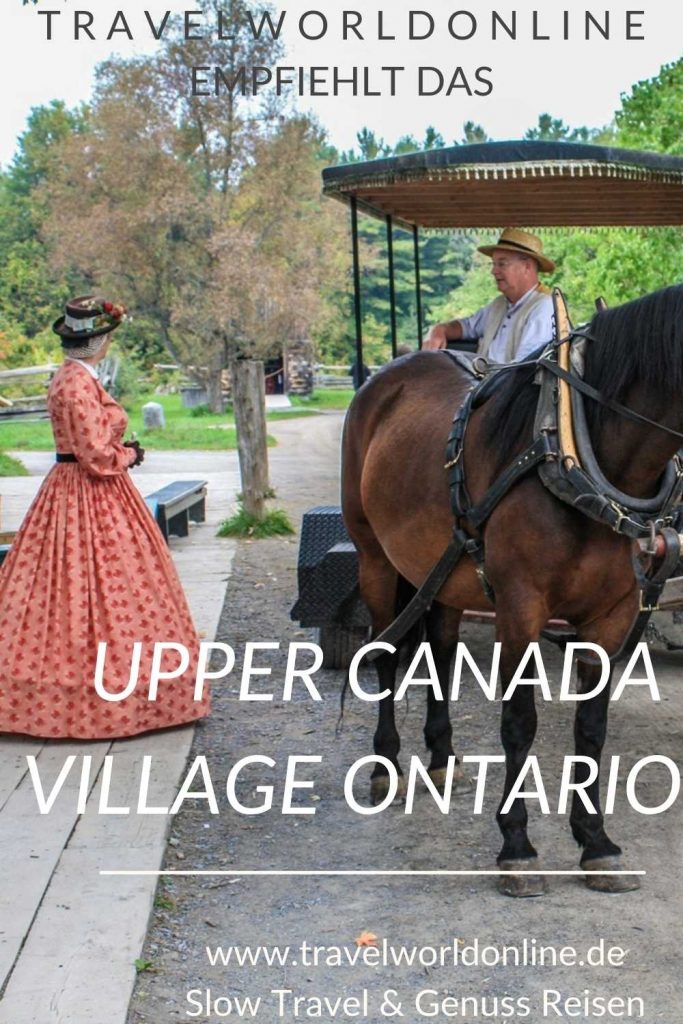
Do you know this?
- packing list for campers
- A nostalgic stroll through the good old days in Upper Canada Village
- Manhattan - the heart of New York City
- Camargue Frankfeich - Experience the home of horses and bulls
- Discover Old Quebec: what's the best way to experience Old Quebec
- Ottawa Winterlude
- Ottawa Winterlude hotels
- Ontario holiday for Christmas - experience a sea of lights
- Halifax Nova Scotia Canada
Source: On-site research supported by Tourism Ontario and the Canadian Tourism Commission. However, our opinions remain our own.
Text: © Copyright Monika Fuchs and TravelWorldOnline
Photos: © Copyright Monika Fuchs and TravelWorldOnline
Note: The article first appeared in the travel magazine 360 ° Canada
